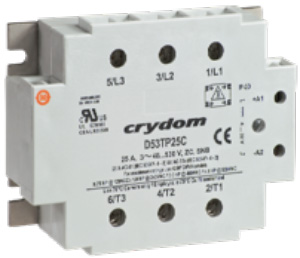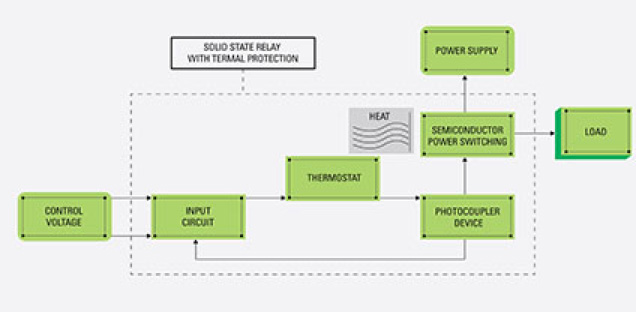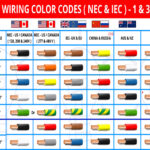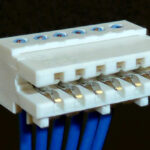by Rogelio Castaneda and Oscar Rivera, Sensata Technologies
What happens when a large conveyor belt or assembly line system gets jammed and the motor continues to run? What happens when an industrial cooling system or a commercial oven is forced to work too hard because a door was left open? The electric motors can overheat, and fail, causing serious damage and long costly downtime for troubleshooting and repair.
An electric motor can also overheat when it is forced to operate in a high-temperature environment, under constant over-current conditions, or continuously without maintenance. Motor overheating can also be caused by mechanical failure of the application equipment itself or when a motor is started at an incorrect current value. In the latter case, the motor starts operation in a much warmer condition that the system’s originally assigned temperature.
Most large motor-driven machinery have a system attached to the motor’s power supply that senses overheating and turns off the motor to prevent this damage. In many cases, this device is an electrical relay that turns power on and off. There are two main types of these relays – electro-mechanical (EMRs) and solid state (SSRs).
Because EMRs are mechanical based and have moving parts, they are highly susceptible to magnetic noise, vibration, shock and other outside influences that reduce their operational life. In comparison, the durable, solid-state design of SSRs means there are no moving parts to affect wear or accuracy, thereby providing more predictable operation and much longer life. The average lifespan of electro-mechanical relays is only hundreds of thousands of cycles. SSRs often outlast the equipment in which they are installed!
SSRs provide faster switching than EMRs, making them adaptable to a wider range of high power load applications. They operate silently (without the annoying EMR clicking sound), require lower operational power and produce little electrical interference. Shock and vibration resistant, SSRs can withstand harsh environments and continue to operate accurately and reliably, whereas EMRs often need frequent replacement, making them very undesirable in harsh conditions.
SSRs excel over EMRs in other ways as well. They are compatible with control systems, immune to magnetic noise, and are encapsulated to protect critical components. Their solid-state design makes them position insensitive and provides design engineers more flexibility to mount SSRs anywhere within an application – whether sideways or upside down. SSRs can be installed in places where there is heavy vibration with no interference in performance, whereas mechanical-based EMRs are very sensitive to positioning, shock and vibration, thereby restricting design options.
With all the advantages that SSRs provide, it is understandable that they are more expensive than EMRs. However, this significant price point disparity becomes a non-issue when one factors in the over 5 million hours of life that SSRs provide.
SSR thermal management issues
As SSRs generate heat when conducting current, there is a thermal management component to their operation. Should overheating occur and damage an SSR, diagnosing and replacing the SSR can take time while the assembly line, machine, or manufacturing system is down and out of service, running up even more costs. When the SSR turns on to conduct load current, it also generates internal heat. Failure to adequately protect the solid-state relay can cause damage to the relay or to the load.
To solve this overheating challenge, Sensata developed a new and unique SSR technology that integrates a thermostat into the SSR itself. This new game-changing design incorporates all the advantages of standard SSR technology, but adds an embedded thermostat that prevents the SSR from overheating. Before this new generation SSR was developed, engineers building in their own thermal protection had to dedicate considerable time and resources in the design process for their specific application.

These new SSRs are being used in commercial refrigeration systems, industrial ovens, HVAC/R, sterilization equipment, molding and extrusion machinery and welding equipment. Other uses include heavy-duty conveyor systems, such as those in construction, mining, packaging and material handling.
How does it work?
The new SSR cuts off input circuit power when the temperature of the SSR itself goes beyond the specified maximum as determined by the application requirements. After a brief cool down period, power is automatically turned on again.
This automatic thermal protection is accomplished by means of the integrated thermostat embedded in the SSR. The thermostat senses the internal temperature of a mechanical interface with a metal plate where the internal power-switching device is mounted. If the heat exceeds the normal range, it sends a signal to the SSR to turn off the power. This built-in thermal protection prevents overheating conditions by providing a trip before equipment damage can occur, thereby saving time and money.
For machine designers wanting to take advantage of this new technology and save themselves the trouble of doing it themselves, it is first necessary to select the appropriate SSR for the load that needs to be controlled. The most important consideration is the SSR’s ambient operating temperature, which will allow for calculating the best derating for ampacity. In other words, engineers need to identify the maximum power rating, current rating, or voltage rating for which the SSR is rated; then use less than those maximum ratings. This will prolong SSR life and prevent premature failures. Other points important in the selection process are the power the SSR dissipates and the heatsink used.
Since the 1970s, traditional solid-state relays have offered a proven electronic switching solution for a variety of applications, providing a longer lasting, more versatile, flexible and robust solution than electromechanical relays.
New solid-state relays featuring integrated thermostats are now available that can prevent the SSR overheating and identify heat sinking issues and help improve system safety, efficiency and longevity. This product evolution will make it quicker and easier for engineers to develop cost effective and highly reliable thermal protection systems for a wide range of industrial electrical and heavy motor driven applications.
Rogelio Castaneda is a Design Engineer at Sensata Technologies. Oscar Rivera is Engineering Director at Sensata Technologies.








Leave a Reply
You must be logged in to post a comment.